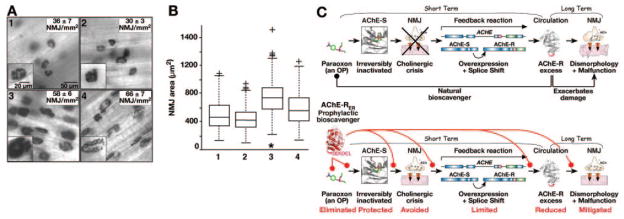Figure 5.
AChE-RER pretreatment ameliorates morphological NMJ damage induced by OP poisoning. A) Mice were either treated with PBS (1), 400 U AChE-RER (2), an 0.8 × LD50 of paraoxon (3), or 400 U AChE-RER and an 0.8 × LD50 of paraoxon (4). 10 days post-treatment, diaphragm muscle was dissected and stained for catalytically active AChE to visualize the number and size of NMJ. NMJ density (NMJs/mm2) was measured and indicated by an average ± SE within each section, A1–A4. B) Analysis of NMJ density and morphology. NMJ area (μm2) from the analysis above was box plotted using the MATLAB 7.0.1 software. The box is built from lines at the lower quartile, median, and upper quartile values. The whiskers show the rest of the data and outliers indicated by +, present data beyond the whiskers. *P < 0.01 (median test). Both analyses suggest that paraoxon exposure increased both the density of NMJs and the fraction of large synapses (see also insets in A3 compared with A1). Pretreatment with plant-derived AChE-RER prevented at least part of the effect on NMJ area, while plant-derived AChE-RER alone did not alter NMJ density or area within the nonexposed diaphragm. C) Model for mechanism of protection from acute and chronic consequences of OP intoxication.

